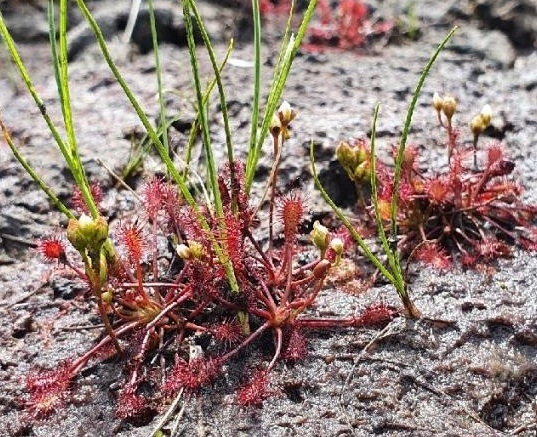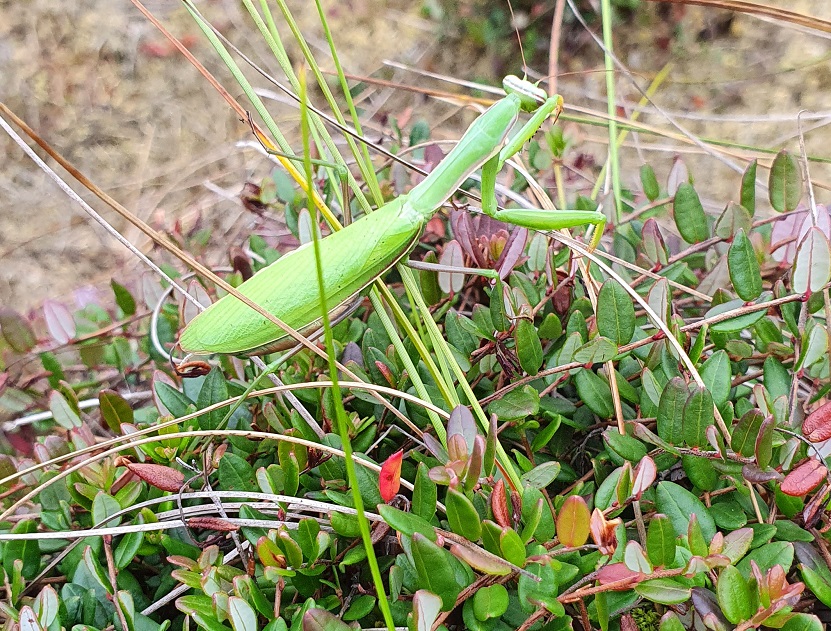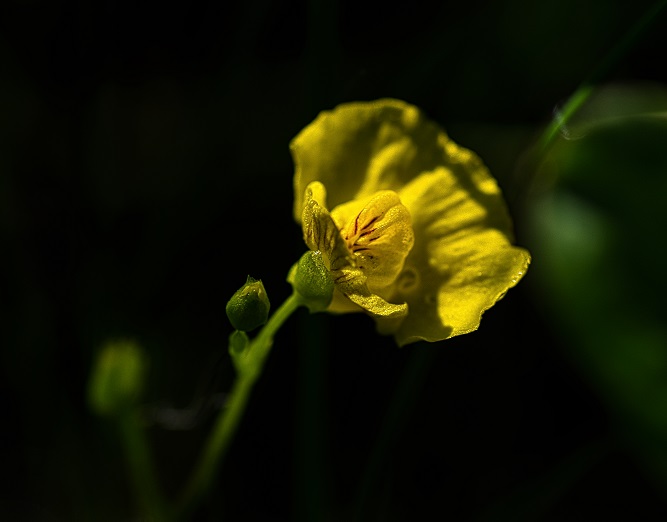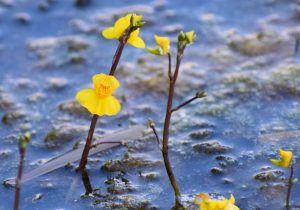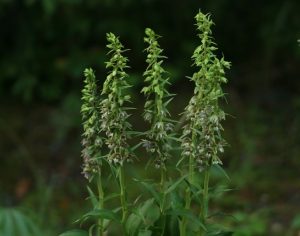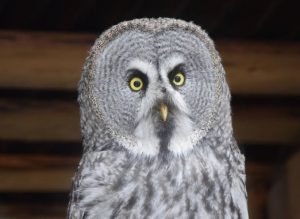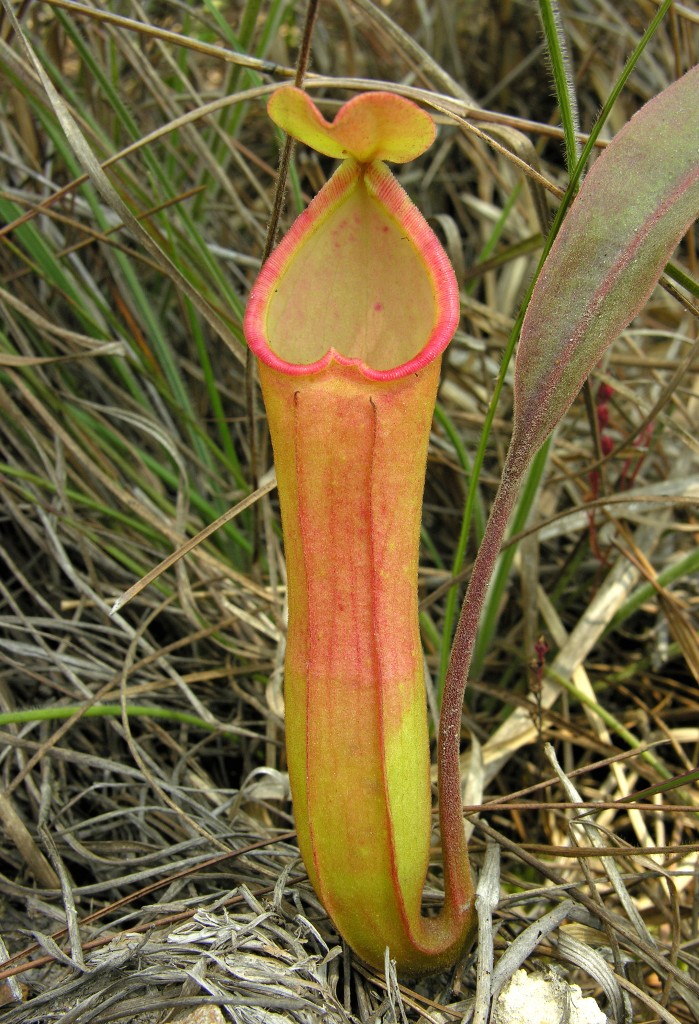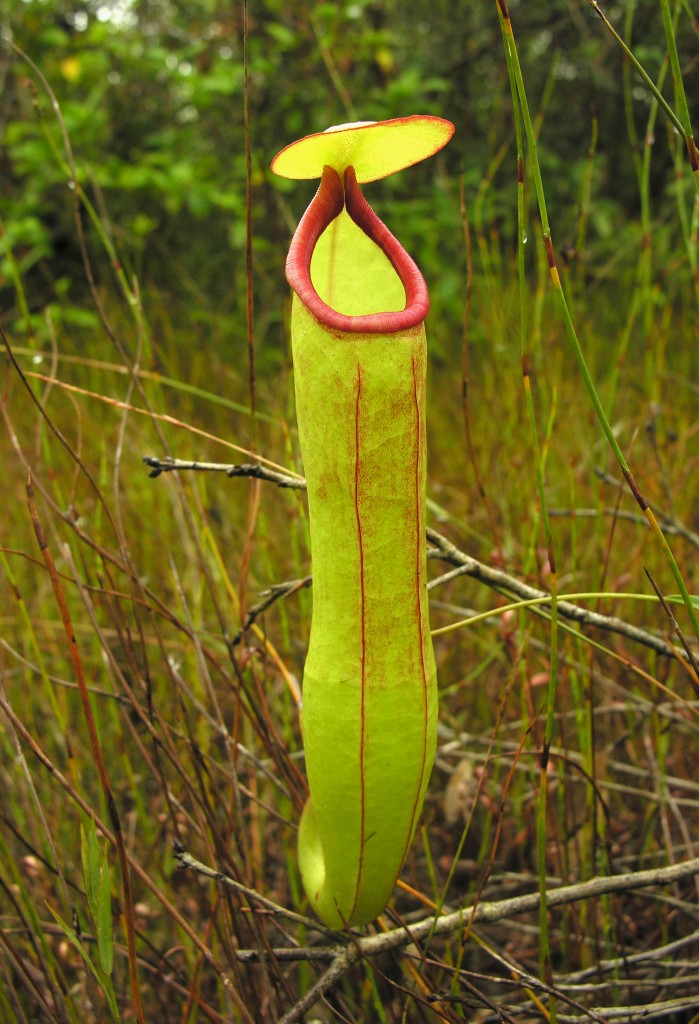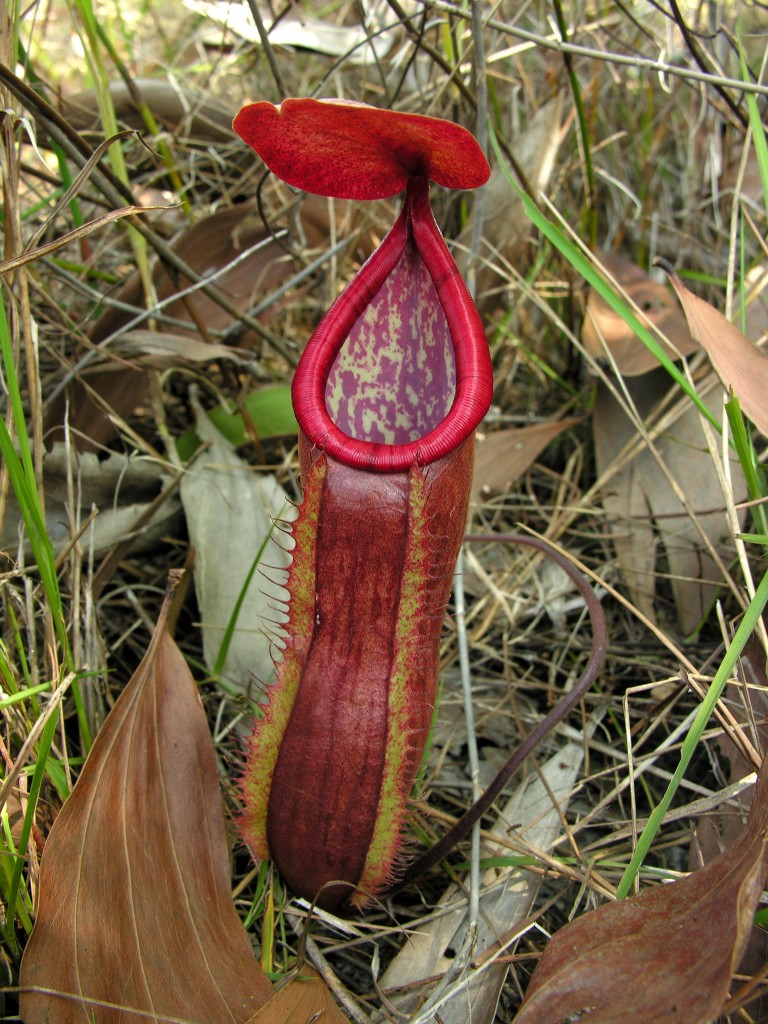Thailand is a country of great biological diversity, and a high proportion of the plant and animal species found in Thailand, differ from that found in Peninsula Malaysia and other parts of South East Asia. This is partly because, rainfall patterns in Thailand are strongly seasonalized, and a pronounced dry period is experiences for many months of the year. The severity and length of the dry period also varies geographically, but in northern Thailand, drought generally ensues from November until April, and during this time, many months may pass with little or virtually no rainfall. The dry season is so acute, that species of endemic plants have evolved adaptations in order to survive the ground. Uniquely, many of the endemic pitcher plants (Nepenthes) of this region have adaptations to store water and nutrients, such as swollen, tuberous roots and underground stems. Such adaptations enable many of the Thai Nepenthes to populate habitat that is very atypical for the genus, notably areas where the substrate dries out completely during the dry months.
Three species of Nepenthes occur in Thailand that are tolerant of drought (N. kampotiana, N. kongkandana N. smilesii). In all three species, the storage organs generally take the form of a swollen, fleshy, carrot-shaped underground stem, which may be branched and divided. Some roots may also be enlarged, although it is not clear if they serve a storage function or not. Usually, the foliage of these Nepenthes withers during the dry season, but the vines are not entirely killed, and each growth point enter into a stage of semi-dormancy and stops producing foliage (or only small leaves that lack pitchers) for as long as the droughts persist. If the drought is exceptionally severe or prolonged, all above-ground parts of the plant may die completely, and the rootstock will remain dormant until rain returns and new growth can be produced and sustained. The Nepenthes of Thailand which possess water storage organs generally do not become dormant on a cyclic or regular basis, but rather, respond to drought by loosing foliage and dying back. All three species produce foliage that is relatively similar. In all three cases, the leaves are narrow, however the shape, size and colouration of the pitchers varies significantly.
N. smilesii is the best known species. It was named in honour of the British plant collector Frederick Henry Smiles who collected the first herbarium specimens of this plant from Thailand in the early 1890s. Unfortunately, much confusion has been caused by horticultural nurseries distributing N. smilesii plants under the name of N. thorelii.
The limits of the distribution range of N. smilesii remain unclear. It occurs widely across north east Thailand, southern Laos and possibly also western Vietnam. It is recorded to occur from 200–1,500 m altitude, although generally at elevations above 800 m. N. smilesii is found growing in a very wide range of habitats, including lowland plains, amidst sparse stunted, lower montane forest, bamboo forest, highland savannah and on the margns of highland pine forests. It often grows in pure sand, mostly in open areas, exposed to strong or direct sunlight, and readily produces a stem up to 5 m long, and scrambles and climbs through surrounding vegetation.
N. smilesii is also remarkable because highland populations of this plant are exposed to possibly the lowest temperatures of all Nepenthes. Populations of N. smilesii on the summit of Phu Kradung occur at 1,200–1,300 m altitude and are regularily exposed to nighttime temperatures below 10°C. During my field observations of this species on Phy Kradung during February 2008, I recorded nighttime temperatures as low as 6°C and according to the park rangers, temperatures as low as 1°C have been recorded.
The lower pitchers of N. smilesii are up to 25 cm long and 6 cm wide, but usually are much smaller than these maximum measurements, especially during the dry season. The bottom half of the pitcher is ovate and variably swollen and inflated (although in some strains, greatly elongated). Above this part, the width of the trap narrows (with a faint hip), and becomes cylindrical or slightly infundibular towards the pitcher opening. Wings often run down the front of the trap and may be up to 8 mm long, fringed with filaments 10 mm in length, although sometimes the wings are partly expressed, or reduced entirely to arrow ridges. The peristome is up to 13 mm wide, and is slightly expanded at the sides and back of the pitcher opening. Often, the peristome is raised at the front of the pitcher opening and forms a distinctive triangular point. A narrow gap a few milimeters wide is often present at the back of the peristome, below the lid. The peristome is lined with inconspicuous ribs up to 0.8 mmm high, spaced up to 0.6 mm apart (although the peristome ribs may be hardly discernable at all). The lid is elliptic, up to 6 cm long, 5 cm wide and lacks an appendage. The spur is up to 10 mm and generally unbranched, although it may be divided in some populations, Marcello Catalano (personal communications).
The exterior of the lower pitchers may be yellowish green, often suffused orangish, pink, or red. The interior of the pitcher may be cream, light yellow or light pinkish, sometimes with faint red flecks. The peristome may be yellow, orange, pink or red, usually without bands or stripes. The lid may be the same colour as the exterior of the trap. The colouration of the lower pitchers is usually subtle and light, red colouration (where present) is flushed rather than bold.
The upper pitchers are up to 28 cm long, 7 cm wide, wholly infundibular, although narrowly so and sometimes greatly elongated. The bottom third of the pitcher may be slightly swollen, sometimes with a very faint hip above. Wings are reduced to narrow ridges which run down the corners of the flattened front face of the trap. The peristome is up to 6 mm wide and is slightly expanded at the sides and back of the pitcher opening, or not at all. The peristome is lined with fine ribs up to 0.5 mm high, spaced up to 0.5 mm apart (although often the peristome ribs may be hardly discernable at all). All other parts are consistent with the lower pitchers.
The colouration of the upper pitchers may be the same as the lower traps, or (more usually) the upper pitchers are pure yellowish green.
N. kampotiana is less well known. It was first collected close to the town of Kampot in Cambodia, hence its name, however has remained little documented over the last fifty years. N. kampotiana is presently known only from the coastal lowlands of southern Cambodia and neighbouring parts of eastern Thailand and western Vietnam.
All known populations of N. kampotiana occurs between 0–350 m altitude, predominently in clearings amidst sparse trees, shrubs and scrub on lowlying coastal wetlands, or occasionally in open areas on ridge sides and the slopes of hills. It readily forms a branched stem up 6 m long and scrambles and climbs amidst surrounding vegetation, usually in strong or direct sunlight. All parts of the foliage of N. kampotiana plants are usually glabrous (lacking hairs)
The lower pitchers are up to 12 cm long and 4.5 cm wide. The bottom half of the pitcher is ovate ad variably swollen or bulbose. Above this part, the width of the trap narrows (often with a faint hip), and becomes cylindrical or tapers slightly towards the pitcher opening. Wings up to 8 mm wide, fringed with narrow filaments up to 10 mm long run down the front of the lower pitchers. The peristome is cylindrical, up to 9 mm wide and of a consistent width around the pitcher opening, except for immediately below the lid, where it is slightly expanded and raised. The peristome is lined with fine ribs up to 0.3 mm high, spaced up to 0.5 mm apart. The lid is elliptic, up to 5 cm long, 4 cm wide, and lacks an appendage. The spur is unbranched and up to 5 mm long.
The exterior of the lower pitchers may be yellow, green, orange, pinkish, or red. The interior of the pitcher is light yellow or creamish white, often lined with small dark red or purple flecks. The peristome may be white, yelllow, pinkish or red, and often has a dark inner margin. The lid is orangish red, often with small dark purple flecks on its upper surface.
The upper pitchers are up to 17 cm long and 4 cm wide. The bottom quarter to third of the pitcher is narrowly ovate, and above this part, the width of the trap narrows very slightly (with a very faint hip or no hip at all) and is cylindrical to the pitcher opening. Wings are reduced to narrow ridges which run down the front of the upper pitcher. The peristome is cylindrical, up to 6 mm wide, and is of a consistent width around the pitcher opening, except for immediately below the lid where it is slightly elongated. A gap of a few millimeters is often present in the peristome at the back of the pitcher opening. The peristome is lined with extremely fine ribs up to 0.1 mm high, spaced up to 0.3 mm apart (although the peristome ribs may be hardly discernable at all). The lid is elliptic, with a slightly cordate base, up to 5 cm long and 4 cm wide. The spur is consistent with the lower pitchers.
All parts of the upper pitchers are pure yellowish green, except for the peristome which may be bright pink, red or purple. Often the vestigal wing–ridges and the edge of the lid may be pinkish, red or purple, although sometimes these parts are yellowish green too.
The third species of Nepenthes from Thailand which produces swollen, underground roots is N. kongkandana. This plant has only recently been described. It was named after Thai botanist Kongkanda Chayamarit and is known only from southern Thailand, and occurs from the town of Hat Yai in Songkhla province to the Khao Sok National Park in Surat Thani. Small, isolated populations also occur south of Hat Yai too. All populations of this species which I observed, occurred in open areas, amidst sparse trees, shrubs and scrub on lowlying coastal plains from 0–50 m altitude. N. kongkandana produces a branched stem up to 2 m long, and scrambles or climbs through surrounding vegetation. In exposed, open areas, where it grows away from taller shrubs or trees, it grows as a compact clump of self supporting stems up to 80 cm tall.
The lower pitchers are up to 25 cm long and 5 cm wide. The bottom half of the pitcher is ovate and slightly swollen. Above this part, the width of the pitcher narrows slightly (with a very faint hip or no hip at all), and becomes cylindrical or slightly infundibular towards the pitcher opening. The width of the pitcher may narrow, just below the peristome. Wings up to 11 mm wide, fringed with filaments up to 13 mm long run down the front of the lower pitcher. The peristome is prominent, bulbous and rounded (particularily in comparasion to all other Nepenthes of Indochina). The peristome is cylindrical, up to 17 mm wide, glossy, and lined with fine ribs up to 0.8 mm high, spaced up to 1 mm apart. The lid is elliptic or orbicular, up to 5.5 cm long and 5 cm wide and lacks an appendage. The spur is unbranched and up to 5 mm long.
The colouration of the lower pitchers is vibrant and highly variable. The exterior of the trap may be red, reddish brown or purple, sometimes mottled with faint darker purple blotches. The wings are often yellowish, orange, red or green (and may be especially brightly coloured in developing or newly opened pitchers). The peristome may be a vivid shade of yellow, orange, red, pink or purple, usually without bands or stripes. The interior of the pitcher is light yellow, or cream, sometimes with faint dark purple blotches and flecks, and the lid (both sides) may be pure yellow, green, orange, red or purple.
The upper pitchers are up to 27 cm long and 5 cm wide. The bottom quarter to third of the pitcher is narrowly ovate. Above this section, the width of the pitcher narrows very slightly (with a very faint hip or no hip at all), and is cylindrical to the pitcher opening. Wings are reduced to narrow ridges which run down the front of the upper pitcher. The peristome is up to 12 mm wide, and is similarly bulbous and rounded, as in the lower pitchers. It is lined with fine ribs up to 0.4 mm high, spaced up to 0.5 mm apart. All other parts are consistent with the lower pitchers.
The exterior of the pitcher may be light yellowish green, orangish, red or faint purple, often mottled with faint dark red or faint dark purple blotches. The interior of the trap is light yellowish green, often with faint red and purple flecks. The peristome may be a vivid shade of yellow, orange, red, pink or purple, usually without bands or stripes and the lid (both sides) may be pure yellow, green, orange, red or purple. Often all parts of the upper pitcher are light yellowish green.
All three species are very closely related and may be difficult to tell apart. N. kampotiana is distinguished because it produces foliage that is completely glabrous. The distinction between N. kongkandana and N. smilesii is less clear, but both produce foliage lined with short hairs, and generally N. kongkandana can be distinguished from this species by its more roboust, colourful pitchers, with a bulbous peristome, borne on long tendrils.
Unfortunately most populations of N. kampotiana, N. kongkandana and N. smilesii occur outside protected areas, mostly in coastal lowlands that are at risk of being developed, or cleared for agriculture. A detailed up to date study of the distribution of all species is required, since N. kampotiana and N. kongkandana are not common and may be threatened with extinction in the wild.
Stewart McPherson
